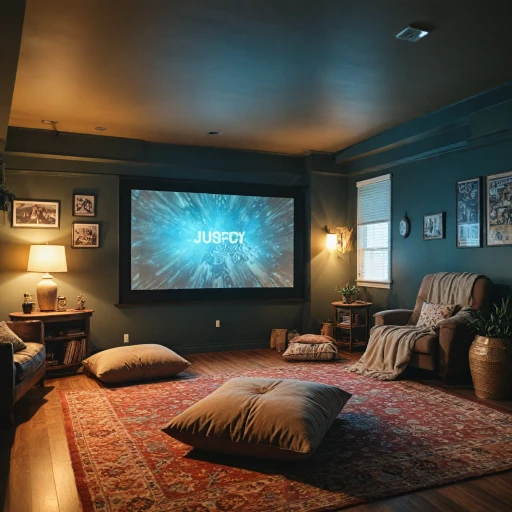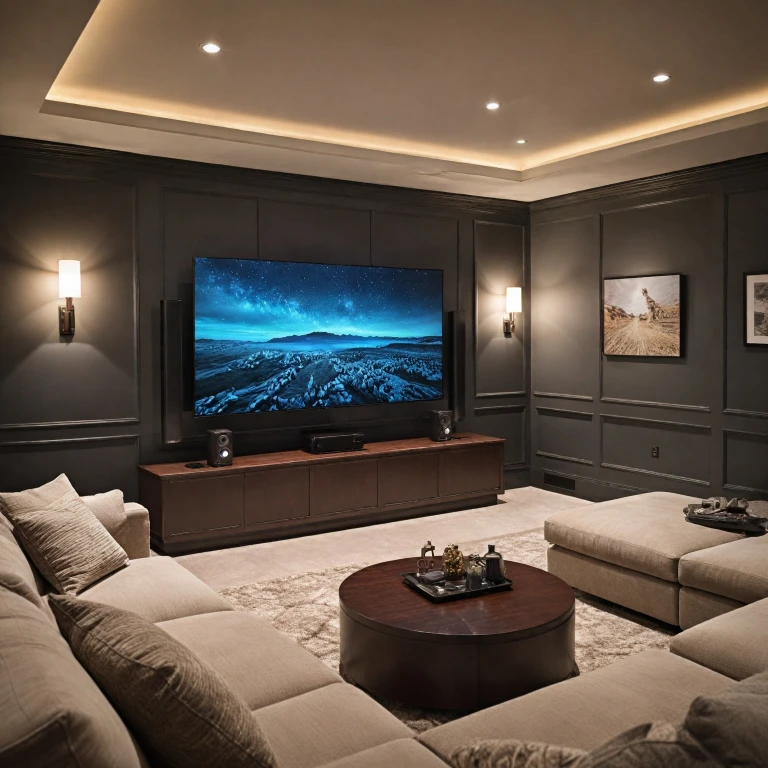Understanding Wireless HDMI Technology
Exploring the World of Wireless HDMI Technology
Forget about the mess of tangled cables; wireless HDMI technology is here to declutter your home theater setup by eliminating traditional HDMI cables. Wireless HDMI plays a crucial role in modern home entertainment by utilizing a transmitter and receiver to transmit high-definition video and audio signals from your source device, such as a Blu-ray player, to your display unit wirelessly.
By replacing conventional cables with wireless HDMI systems, you have the flexibility to connect multiple devices across the room without the need for long HDMI cables sprawling across the floor. The wireless video and audio signals are transmitted seamlessly, ensuring that your viewing experience remains uninterrupted. The transmitter unit sends out the video and audio signals, which the receiver unit captures on the other end, delivering the content to your television or projector.
Wireless HDMI extender kits offer an extensive range that allows devices to connect even when they are in different rooms. Popular models like Nyrius Aries provide a plug-and-play experience, meaning they can be set up in a matter of minutes with no complex installation process. Typically, you can find support for not only full HD video but also stereo audio, ensuring an immersive experience.
It’s important to note that selecting the right product is essential to making the most out of wireless HDMI technology, as various systems offer different levels of support and features. For an insightful understanding of one of the best options available, check out
this comprehensive guide on HDMI modulators that can enhance your home theater setup.
Benefits of Using Wireless HDMI in Home Theaters
Unlocking the Advantages of Going Wireless
Investing in wireless HDMI for your home theater offers numerous benefits that enhance both convenience and aesthetics in your entertainment space. Utilizing HDMI technology wirelessly allows for a clean setup, eliminating the tangled mess of cables that can clutter your room. Wireless HDMI systems use a transmitter to send an audio-visual signal to a receiver, delivering you an exceptional viewing experience without the need for HDMI cables.
Picture the freedom of positioning your video output devices like Blu-ray players or gaming consoles anywhere in your room, unrestricted by cable lengths. With a reliable wireless setup, the HDMI transmitter sends signals to a receiver unit that connects to your television or projector. This flexibility in equipment location not only enhances room aesthetics but also optimizes the overall sound and video quality you receive.
Easy-to-install HDMI wireless extenders support a range of devices and tend to come with plug-and-play capabilities. This means you can simply power up the units and connect them to your devices via USB, creating a seamless connection without complicated setups. With wireless HDMI systems, signal delay is mitigated, ensuring swift video transmission and stereo audio delivery.
Moreover, cutting-edge products in the market offer robust solutions like the Nyrius Aries transmitter receiver system, which supports high-definition 1080p video quality, delivering crisp and clear images. Whether you're watching movies, sports or mirroring content from your computer, systems like these are engineered to handle high-bandwidth content without compromising reliability.
As you explore the options available, consider reviewing
some of the top HDMI modulators for a comprehensive understanding of the best products suited to your needs. Opting for a high-quality HDMI wireless system ensures your receiver and transmitter units perform efficiently, providing you with a high-quality home theater experience.
Choosing the Right Wireless HDMI Kit
Picking the Perfect Wireless HDMI Solution
Selecting the right wireless HDMI kit is crucial for a seamless home theater experience. With numerous options available, determining the best product involves several considerations to ensure compatibility with your setup and optimal performance.
Start by identifying the scope of your needs. If you require a system that transmits high-quality video and stereo audio without interference, focus on kits designed specifically for home theaters. Some systems, like the Nyrius Aries, are popular for their reliable signal transmission and ease of use.
Consider these factors when selecting your wireless HDMI solution:
- Range and Coverage: Evaluate the range your wireless HDMI transmitter and receiver need to cover. Ensure it’s capable of transmitting signals across your desired room or entire home without losing quality. Typically, units such as HDMI extenders suited for room-to-room coverage are ideal.
- Video and Audio Quality: For high-definition content, verify that the kit can support high-definition video output and clear audio. Be on the lookout for systems supporting formats up to 4K and adjustable audio channels.
- Compatibility: Ensure compatibility with your existing devices, such as Blu-ray players, gaming consoles, and projectors. Bluetooth and Wi-Fi integrated products can offer added convenience over traditional HDMI cables.
- Ease of Installation: Opt for a plug and play system that minimizes setup hassle. Those seeking ease might find the ease of installation with HDMI wireless extenders appealing, requiring minimal knowledge of HDMI cables and USB connections.
- Latency and Lag: Look into the latency specifications if you plan on using the setup for gaming or interactive media. Lower latency ensures a more seamless experience without noticeable delays.
- Power Source and Management: Consider how the system is powered, especially if it requires multiple power outlets or relies on USB power. Efficient power management enhances performance and prolongs the lifespan of the equipment.
Finding the right balance between features, price, and performance is key. With the correct setup, your home theater system will deliver exceptional quality, handling both hdmi transmitter and receiver tasks seamlessly.
Setting Up Your Wireless HDMI System
Steps to Deploy Your Wireless HDMI Setup
Setting up a wireless HDMI system can seem daunting at first, but the process can actually be quite straightforward. Here is a practical guide to getting your system optimized for the best performance.
Gather Your Equipment
To begin, confirm that you have all the necessary components. Typically, a wireless HDMI kit includes:
- A transmitter unit that sends the video and audio signals
- A receiver unit that connects to your TV or projector
- Necessary cables (HDMI cable, USB power cable)
- Power adapters for both the transmitter and receiver
Position the Transmitter and Receiver
Place the HDMI transmitter close to your media source, such as your Blu-ray player or gaming console. The transmitter should be connected via an HDMI cable. Next, place the receiver unit near your display device, which could be a TV or projector. Ensure that both units are within the signal range specified by your product manual, which is often around 30 feet for standard systems.
Connect Power Sources
Use the USB power cables to connect the transmitter and receiver units to power. Most units can be powered by plugging into a USB port available on your media device, though AC outlets can also be used with an adapter if necessary.
Link the Devices
After securing connections, power on both units. Many systems are designed for a plug and play experience, meaning they should automatically pair and establish a connection. Look for indicators or lights on the units to confirm the link has been made.
Adjust Settings for Optimal Performance
For the best results, inspect the placement of the units. Wireless extenders can sometimes be affected by obstacles like walls or heavy Wi-Fi congestion, which can diminish signal strength. If you encounter issues, try repositioning the units or adjusting the antennas if applicable. Additionally, make sure HDMI systems are set to support the desired resolution and audio output.
Test Your System
Once setup is complete, test the system by playing video content to check for synchronization between audio and video, and ensure the signal is stable. If you encounter any issues, refer to troubleshooting tips discussed earlier to resolve common hurdles such as lag or interference.
By following these steps, you'll be well on your way to enjoying a seamless and cable-free home theater experience through wireless HDMI technology.
Troubleshooting Common Wireless HDMI Issues
Common Challenges and How to Overcome Them
If you've already set up your wireless HDMI system but are experiencing issues, don't worry. Many common problems have straightforward fixes. Here are some common challenges and effective solutions:
- Signal Interference: Wireless systems can face interference from other devices. Ensure your wireless HDMI transmitter and receiver are within a reasonable range—often recommended to be under 30 feet free from barriers like walls. Reduce interference by minimizing the number of wireless devices operating on similar frequencies.
- Audio or Video Lag: Sometimes, the audio and video may not sync properly. Check your HDMI cable connections are secure. Some systems come with a lip-sync adjustment feature in the settings; use it if available.
- Power Issues: Both the transmitter and receiver units require power. Make sure they are plugged in properly and receiving an adequate power supply. Consider using a direct wall plug instead of a USB power adapter if stability is an issue.
- Weak Signal Quality: If video and audio quality are poor, confirm that your HDMI extender kit supports high-definition video formats. Also, ensure there are no physical commercial-grade obstacles blocking the signal path from the transmitter unit to the receiver.
- Device Compatibility: Verify that your wireless HDMI system supports the resolutions and formats you are using. Troubles can often emerge if your system doesn't support the output settings of your Blu-ray player, gaming console, or streaming device. Checking support compatibility might save you prolonged frustration.
- No Output: Before troubleshooting further, ensure every device in the chain—like your projector or TV—is set to the correct input source. Also, make sure cables are snugly connected to the relevant ports.
Most wireless HDMI systems, such as the Nyrius Aries products, are designed for plug-and-play, which simplifies setup and reduces troubleshooting complications. Always reference the user manual provided by the manufacturer for specific instructions tailored to your products and setup environment. Remember, patience and careful observation generally resolve most setup and operational glitches over time.
Future Trends in Wireless HDMI Technology
Exciting Innovations on the Horizon
With the rapid advancements in technology, the landscape of wireless HDMI systems is bound to see some impressive developments. These innovations promise to enhance the overall user experience in home theater setups.
One area to watch is the improvement in HDMI extender capabilities. Future models are expected to deliver even more robust signal strength over longer distances without compromising the quality of audio or video. This means that larger rooms or multi-room setups could benefit significantly from improved wireless range.
Additionally, the integration of usb power options directly into receiver units might become more commonplace. This would simplify setups by eliminating the need for bulky power adapters, making these systems more plug play than ever before.
The ongoing development of WHD (Wireless Home Digital Interface) technology is also set to revolutionize audio video transmission. This innovation could support higher video resolutions and richer stereo audio, providing an improved cinematic experience. The potential for devices like blu ray players and gaming consoles to easily connect to wireless systems will add to the convenience factor.
Another exciting prospect is the enhancement of signal management capabilities in HDMI transmitter and receiver units. Future products could feature advanced signal processing to reduce latency and interference, ensuring a smoother performance even in environments with multiple wireless signals.
For enthusiasts of products such as the nyrius aries, the focus on creating a seamless user experience without sacrificing the quality of the video transmitter and hdmi wireless capabilities will continue to drive innovation in extender kits.
Overall, keeping an eye on these trends will help you maximize your home theater setup, as manufacturers push the envelope on what’s possible with wireless video transmission systems. For further insights into outfitting your theater, explore additional resources available on choosing the ideal components.

